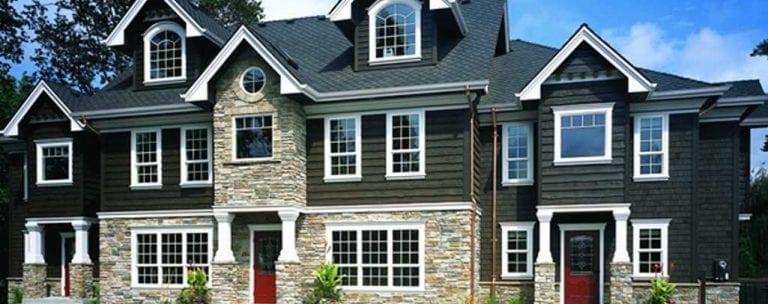What to Look for When Buying Windows

Picture this: you’ve started renovating your home, and you notice your home windows need replacing. You go to place an order, and you start to see all these different numbers and ratings. U-factor? Air leakage? What does it all mean?
There are plenty of details to take into account when buying windows, and with so many different window options, it can be hard to know where to start. But it’s worth taking the time to understand the labels and metrics that come along with windows. After all, they do separate us from the weather outside!
To that end, there are two main factors to look at when researching windows: energy efficiency and climate. We built this guide to explore both factors, so you know exactly what to look for when buying new windows. Here is our comprehensive window buying guide.
ENERGY STAR Label
In an effort to make energy efficiency more accessible to the average consumer, the U.S. Environmental Protection Agency (EPA) created the ENERGY STAR program. When you see a blue ENERGY STAR sticker on a product, it means that the product has met specific efficiency criteria laid out by the EPA and the Department of Energy.
So what does it mean when a window has an ENERGY STAR label?
To qualify for ENERGY STAR status, energy-efficient windows must:
- Be manufactured by an ENERGY STAR partner;
- Be independently tested, certified, and verified by the National Fenestration Rating Council (or NFRC—more on this later), and;
- Meet the energy efficiency guidelines set out by the EPA
By looking out for the ENERGY STAR sticker while shopping for energy-efficient windows, you’re doing your part to lower emissions—the less energy you use to heat or cool your house, the better. Minimizing air conditioning or heating not only decreases your carbon footprint but also saves you money! Make sure to look into energy-efficient windows and doors.
NFRC Label
If a window is certified by the National Fenestration Rating Council (NFRC), it will be labeled to allow proper comparison between window options. The NFRC independently rates specific qualities of a window to help you understand its energy performance.
There are four numbers you need to pay attention to when reading an NFRC label. The fifth metric is not required by the NFRC, so you may only see it on certain products. Still, it pays to know what it means.
#1 U-Factor
The U-Factor is the measure of a window’s ability to keep heat inside a room and prevent heat loss. If the heat from your furnace is escaping through the glass, you’re quite literally throwing your money out the window!
You’ll see numbers ranging from 0.20 to 1.20. The lower the U-Factor, the more heat is retained, so keep an eye out for a rating that corresponds with your needs in preventing heat loss.
#2 Solar Heat Gain Coefficient
The solar heat gain coefficient measures your window’s resistance to unwanted heat gain. During the hottest months of the year, keeping heat from the sun out means paying less for air conditioning.
This metric will fall somewhere between 0 and 1. A lower number keeps the heat out and your cooling costs at a minimum, while a higher number will let more heat in and can reduce heating costs.
#3 Visible Transmittance
Windows are installed in part to illuminate our homes, but not all windows are created equal when it comes to letting in light.
Visible transmittance is a metric that tells you how well your window will fill your home with daylight. Scores range from 0 to 1, with higher numbers meaning more natural light will come through. If more light is coming from outside your home, you won’t need to pay as much for interior lighting.
#4 Air Leakage
A small amount of air leaking out of your windows is practically inevitable, but it’s not ideal. Essentially, you’re paying to heat or cool air that’s escaping, the cost of which can add up in the long run.
As such, you’ll want a low number in the air leakage section of your NFRC label. Ratings generally fall between 0.1 and 0.3.
Different operating types of windows can also affect the amount of air leakage. This is discussed in the next section.
#5 Condensation Resistance
As mentioned, window company manufacturers are not required to include this metric on their product’s NFRC labels. If you happen to come across a label with this rating, you should know what to look out for.
A window is assigned a condensation resistance rating between 1 and 100, with a higher number signifying better resistance to condensation. Excess moisture can damage wooden window frames, walls, and windows themselves, so if a manufacturer supplies the condensation resistance number, take it into account when making a purchase.
Should you live somewhere more humid, a higher condensation resistance rating will be your best bet.
Window Operating Types
Another thing to look for when buying windows is the way a window operates. How to choose windows? Since they all serve different functions, many houses will combine several styles of windows.
Notably, a window’s operation affects the amount of air that leaks out. A typical home’s windows will fall into one of three main categories, listed below from least to most air leakage.
Fixed Windows
Because a fixed windows style can’t open, air leakage is minimal. Avoiding air leakage will save you money over time, but fixed windows lack the flexibility of window types that can open.
Additionally, fixed windows aren’t always an option, as many spaces require—or benefit from—ventilation. You’ll often see fixed windows paired with other options when two or more windows are clustered together.
Hinged Windows
Windows with hinged openings are the next best thing when it comes to minimizing air leakage. The sash of a hinged window is sealed tightly with locking handles, keeping most of the air in.
There are three types of hinged windows:
- Awning – These have a hinge at the top and are pushed outwards from the bottom to open.
- Casement – Casement window options are hinged at the side and are opened by pushing outwards.
- Hopper Windows – Hopper windows are hinged at the bottom and open inward with the pull of a handle.
Sliding Windows
Of the three main operating types, the sliding window allows for the most air leakage. The leakage is due to the way that a sliding window is closed; the seal is not as tight as that of a hinged window.
The two most commonly used sliding windows are:
- Single- or double-sliding windows – Single-sliding windows have one fixed half and one sliding half. Double-sliding windows involve two sliding halves. Both options slide open horizontally.
- Single- or double-hung windows – Hung windows slide open vertically. A single-hung window will have a bottom half that slides up. A double-hung window is made up of two sliding halves.
It’s worth pointing out that the difference in air leakage between hinged and sliding windows is not massive, but it is present and worth keeping in mind.
Buying the Right Window for Your Climate
Now that you understand what all the numbers on the labels mean, it’s time to put that knowledge into practice. It’s great that a window is energy-efficient, but the area in which you live will determine exactly what kind of efficiency is best for you.
Think of it this way: a window is essentially a hole in your wall with no insulation. Of course, windows are necessary, but they are the part of your home that is most susceptible to outside temperatures.
As such, you need to determine whether you want your windows to be efficient at letting heat in, or whether you need them to be efficient at keeping heat out. And that will depend on where you live.
If you call southern Texas home, chances are you’ll be pumping the AC during much of the year, meaning you might want a low solar heat gain coefficient and a slightly higher U-factor.
If you reside in the Pacific Northwest, you’re likely more concerned about keeping the house nice and toasty during the colder months. That’s why you might want to consider a higher solar heat gain coefficient and a lower U-factor to make the most of those short hours of sunlight.
U.S. residents can check the ENERGY STAR map to determine which of the four climate zones covers their location.
Combining Different Windows
While you have your overall climate in mind, think about the function of each window as well. You’ll likely find you need to mix and match window types based on the location of the window in your house, the purpose of the window, and so on.
For example, a part of your house that receives a lot of sunlight may require a window style with a different solar heat gain coefficient than a part that doesn’t. Similarly, you may find yourself using a combination of fixed and hinged windows in an area that needs ventilation while keeping air leakage to a minimum.
By knowing what to look for when buying windows, you can tailor your selection of each window replacement to your diverse needs. Your newfound window wisdom should help guide you towards the best available choice, but if you ever have any doubts, don’t hesitate to reach out to us. We’re here to handle any and all of your window installation needs.
Sources:
ENERGY STAR. What is ENERGY STAR? https://www.energystar.gov/about
National Fenestration Rating Council. Independent energy ratings. Informed purchase decisions. www.nfrc.org/energy-performance-label/#tabs-nfrclabels|0
Energy.gov. Window Types and Technologies. www.energy.gov/energysaver/window-types-and-technologies
HGTV. Windows for Different Regions. https://www.hgtv.com/design/remodel/mechanical-systems/windows-for-different-regions







